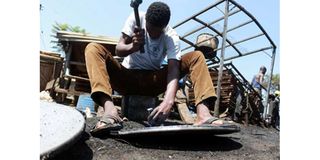Creation of jobs and wealth calls for sound policies and a funding strategy

A young man moulds a metallic pan at Jua Kali workshop in Kibuye Market, Kisumu.
For three days this week, Laikipia and the State Department for Industrialisation jointly hosted this year’s Africa Industrialisation Week celebrations. The choice of word is rather rich, given that there is not much to celebrate.
Industrialisation requires deliberate policy and action. It will not take place by happenstance. Nor by simple policy pronouncements. You will recall that we had a sessional paper on industrialisation by 2020. Today, we have Vision 2030, aimed at making us a middle-income and industrialising country by 2030.
Public sector credit
On micro, small and medium enterprises (MSME), we are on our 6th sessional paper, starting at Sessional Paper No. 10 of 1965, which emphasised access to credit for the emergent African entrepreneurs. That was followed by Sessional Paper No. 1 of 1986, No. 2 of 1992, No. 2 of 2005 and Sessional Paper No. 5 of 2020 on promoting MSME for wealth and employment creation.
Generally, our pronouncements have not been backed by action. And our actions often contradict the intended outcome. Take credit, for instance.
Public sector credit is growing three to four times faster per year, crowding out the private sector. This huge appetite for public credit results in high interest rates.
Yet for small manufacturers, the government provides a paltry Sh3 billion partial guarantee, under which banks are reportedly lending around Sh500 million. The government is also folding up public finance institutions, ostensibly to build a bigger and sustainable one.
Beyond lip service
Kenya Industrial Estates (KIE) lends approximately Sh1 billion yearly, yet in my view Sh150-200 billion is needed annually, if we are to go beyond lip service. Here’s why. Sessional Paper No. 5 of 2020 says there are 7.4 million MSMEs employing 14.1 million Kenyans.
The resources from KIE (Sh1 billion), Industrial Development Bank (Sh300 million), ICDC (Sh500 million), Development Bank (Sh400 million) and State Department for Industrialisation (Sh1 billion) add up to Sh3 billion per year.
This works out to 0.1 per cent of the annual national budget, which stands at Sh3 trillion. And this for a sector that employs 93 per cent of the total labour force! The allocation is less than the Sh3.3 billion economic stimulus Laikipia County and partnering banks have made available to small businesses to boost working capital and for recovery from the Covid-19 crisis!
In the Laikipia case, 83 per cent of the borrowers are micro-firms taking loans of Sh500,000, with 49 per cent taking Sh100,000 or less. Taking Sh200,000 as the average loan size places the financing need for the 7.4 million MSMEs at 1.5 trillion! Since businesses do not borrow at the same time, this brings the annual estimate to the Sh150-200 billion range.
Oddly, the Export Processing Zones Act and the Special Economic Zones Act give tax preference to imported machinery, making it cheaper to import such basic items as motors, pumps, cutting, folding and bending machines. To help micro and small businesses mechanise and automate, we must repeal all these laws.
Ndiritu Muriithi is the Governor of Laikipia County. @NdirituMuriithi




